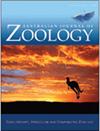Roosting behaviour and the tree-hollow requirements of bats: insights from the lesser long-eared bat (Nyctophilus geoffroyi) and Gould
IF 1
4区 生物学
Q3 ZOOLOGY
引用次数: 1
Abstract
Access to suitable roosts is critical for the conservation of tree-hollow roosting bats worldwide. Availability of roost sites is influenced by human land-use, but also by the roosting requirements and behaviour of species. We investigated roosting behaviour of the lesser long-eared bat (Nyctophilus geoffroyi) and Gould’s wattled bat (Chalinolobus gouldii) in a rural landscape in south-eastern Australia. Forty-five N. geoffroyi and 27 C. gouldii were fitted with radio-transmitters, resulting in the location of 139 and 89 roosts, respectively. Most (88%) roosts occupied by male N. geoffroyi contained only a single individual. During the breeding season female colonies were larger, with maternity roosts containing 18.3 ± 5.7 (s.e.) individuals. Mean colony sizes for C. gouldii were 8.7 ± 1.4 individuals. Both species shifted roosts frequently: on average, individual N. geoffroyi moved every 2.2 ± 0.23 days and C. gouldii every 2.2 ± 0.14 days. Notably, lactating female N. geoffroyi shifted roosts more frequently than non-breeding females. Individuals of both species roosted within a discrete area, with roosts typically <300 m apart; and consistently returned there from foraging up to 12 km distant. This roosting behaviour highlights three important requirements: (1) a relatively large overall number of hollows to support a population; (2) discrete roost areas with a high density of suitable hollows in close proximity; and (3) a range of hollow types to provide the specialised roosts required, particularly for breeding.蝙蝠的栖息行为和树洞需求:来自小长耳蝙蝠(Nyctophilus geoffroyi)和古尔德的见解
获得合适的栖息地对保护世界各地的树洞栖息蝙蝠至关重要。栖息地点的可用性受到人类土地利用的影响,但也受到栖息需求和物种行为的影响。我们调查了小长耳蝙蝠(Nyctophilus geoffroyi)和Gould 's watlebat (Chalinolobus gouldii)在澳大利亚东南部乡村景观中的栖息行为。45只geoffroyi和27只c.g ouldii安装了无线电发射器,分别确定了139个和89个栖息地的位置。大多数(88%)的雄性geoffroroyi占据的巢穴只有一个个体。在繁殖季节,雌性蜂群较大,母巢有18.3±5.7 (s.e)只。古地弓形虫平均菌落大小为8.7±1.4个。这两个物种都频繁地迁移栖息地:平均每2.2±0.23天,geoffroyi和c.g ouldii每2.2±0.14天。值得注意的是,哺乳期的雌蝶比非繁殖期的雌蝶更频繁地转移巢穴。两种的个体在一个离散的区域内栖息,通常间距小于300米;从12公里远的地方觅食回来。这种栖息行为强调了三个重要的要求:(1)有相对大量的空穴来支持种群;(2)离散的栖息区,邻近有高密度的适宜洞穴;(3)一系列中空类型,以提供所需的专门栖息,特别是用于繁殖。
本文章由计算机程序翻译,如有差异,请以英文原文为准。
求助全文
约1分钟内获得全文
求助全文
来源期刊
CiteScore
2.40
自引率
0.00%
发文量
12
审稿时长
>12 weeks
期刊介绍:
Australian Journal of Zoology is an international journal publishing contributions on evolutionary, molecular and comparative zoology. The journal focuses on Australasian fauna but also includes high-quality research from any region that has broader practical or theoretical relevance or that demonstrates a conceptual advance to any aspect of zoology. Subject areas include, but are not limited to: anatomy, physiology, molecular biology, genetics, reproductive biology, developmental biology, parasitology, morphology, behaviour, ecology, zoogeography, systematics and evolution.
Australian Journal of Zoology is a valuable resource for professional zoologists, research scientists, resource managers, environmental consultants, students and amateurs interested in any aspect of the scientific study of animals.
Australian Journal of Zoology is published with the endorsement of the Commonwealth Scientific and Industrial Research Organisation (CSIRO) and the Australian Academy of Science.

 求助内容:
求助内容: 应助结果提醒方式:
应助结果提醒方式:


